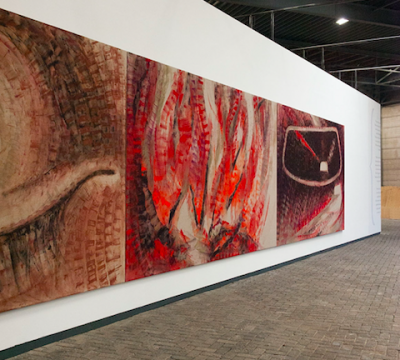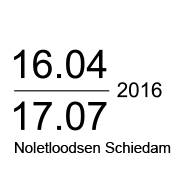robert zandvliet
Robert Zandvliet (Terband, 1970) first established his reputation with large paintings, using genres such as the still life and the landscape as a basis. These images were painted in broad brush strokes, balancing the line between figuration and abstraction. In his recent paintings, Zandvliet takes a new step in exploration of painting. Concrete works of art by the likes of Rembrandt, Hokusai, Pollock and Van Gogh now serve as points of departure for his investigation. As his previous works, these paintings viscerates the line between figuration and abstraction
Robert Zandvliet studied at the Academy for Visual Arts in Kampen and De Ateliers in Amsterdam. In 1994, he won the Prix de Rome. His work is part of many international collections.
Allergic to stories
Cave, eye, fire, rearview mirror.
Say the words three times in a row and a connection is formed, a rhythm, a story, a song. That’s what the human mind does: from loose snippets, words, images we distill a narrative, a drama with a head and a tail, a poem, a nursery rhyme. Cave, eye, fire / rearview mirror.
Nearly three metres high and four-and-a-half metres wide span the four paintings by Robert Zandvliet (1970) at the Noletloodsen. Together they form Frame (2015), nearly fifty square metres of canvas which, as the title explains, is a cut-out, a view of the world around us. But a cut-out of what, a view of what? What story is being depicted here?
Cave, eye, fire / rearview mirror.
For a long, very long time, Robert Zandvliet has been allergic to stories — that is, in terms of his painting. During the nineties, a decade in which neoconceptual art, video and photography are on the up and leader of Documenta Cathérine David labels pictorial art as a prehistoric relic, unfit to depict the dynamics of the late twentieth century, there is suddenly twenty-something fledgeling Zandvliet. After a residency at the then illustrious Ateliers, Zandvliet draws national (former director of the Stedelijk Museum Rudi Fuchs is a well-known admirer) and international attention with minimalist yet extravagantly painted canvases. Again and again the same patterns return: rearview mirrors, hairpins, cinema screens, windows, later also abstract landscapes. Those everyday depictions become Zandvliet’s trademark. They have been blown up to such proportions that one is instantly aware: there is something going on here. Is the artist looking to upgrade his themes? Provide them with the monumental significance they lack in everyday life? Or is it something else entirely?
With Zandvliet, each painting is a remonstrance on the power of pictorial art. An experiment in the best sense of the word — legible from left to right, from bottom to top and in reverse. How does the artist set down his brush? How the roller? What quantity of paint does he use and what effect does that create on the linen? How does he compose his image? How do depth, space and drama emerge from that thin piece of cloth?
Not necessarily through narration or figurative work. That is not Zandvliet’s objective, in these first years. However, the artist evolves and after a pictorial exploration of stones and rocks (exhibited in De Pont in Tilburg two years ago), a sort of story seems to creep into his work. That is a rupture, he admits: ‘I am in search of the limits of narrative.’
In Frame, every image has its own narrative. A cave, a significant symbol in painting because of its references to Plato’s allegory of the cave (and the value of representation). An eye, not allseeing but closed and staring inward. A log fire, by which the primitive human distinguishes itself from animals. A rearview mirror, allowing us, like magicians, to see in two simultaneous directions: the future as well as the past stretched out in front of us.
These images are individual, they don’t form a chain of meanings, rather a rhythm in colour — purple, orange, lilac, white, pink, red, orange, lilac and so on. Each canvas bears a different signature: here the paint has been applied sparingly and the surface bleeds through the image; there it’s voluptuous and splashy. Finding the right balance remains a struggle, because to Zandvliet, ‘it is rarely right’. The goal continues to shimmer in the distance: finding that one image that captures everything — the illusion of reality as well as the abstraction of it.


